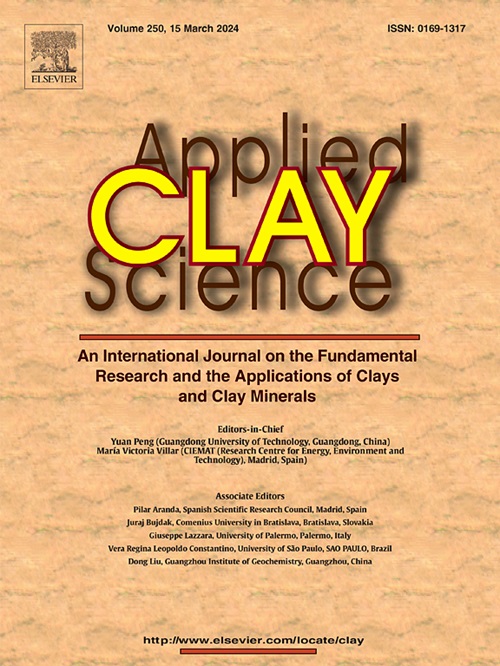Effects of MgO-based cementitious binder on smectites
IF 5.3
2区 地球科学
Q2 CHEMISTRY, PHYSICAL
引用次数: 0
Abstract
Earth materials are subsoils used in construction due to their natural cementing properties. These properties originates from its clay fraction, which becomes cohesive during drying. Unlike common cement, earth materials are recyclable and have no CO2 emission apart from manufacturing. Unfortunately, earth materials containing the abundant clay mineral smectite exhibit large swelling and shrinkage strains. Such earth materials are considered unsuitable for construction unless a stabiliser is added, which is commonly Portland cement or quicklime. This study explored the use of MgO-based cementitious Binder (MB) as alternative with a focus on the mineralogical effect of MB on smectite during hydration. A series of MB/smectite blends and MB components/smectite was cured up to six months to investigate the mineralogical changes and the formation of magnesium (alumino) silicate hydrate. The results showed that MB transformed smectite into Mg-hydroxy-interlayered smectite (Mg-HIS) within hours. The reason is the dissolution of MgO, a main constituent of MB. The dissolved Mg precipitates as Mg-hydroxy in the interlayer and transforms the smectite to Mg-HIS in this process. This is causing a pH increase and may prevent a complete HIS formation as the MgO dissolution mechanism will change once the pH is above the point-of-zero charge of MgO. An advantage of the smectite to Mg-HIS transformation is the strongly reduced the swelling/shrinkage properties of the clay. This suggests that adding MB to smectite could be a superior binding approach compared to quicklime, which primarily causes clay particle flocculation.
求助全文
约1分钟内获得全文
求助全文
来源期刊

Applied Clay Science
地学-矿物学
CiteScore
10.30
自引率
10.70%
发文量
289
审稿时长
39 days
期刊介绍:
Applied Clay Science aims to be an international journal attracting high quality scientific papers on clays and clay minerals, including research papers, reviews, and technical notes. The journal covers typical subjects of Fundamental and Applied Clay Science such as:
• Synthesis and purification
• Structural, crystallographic and mineralogical properties of clays and clay minerals
• Thermal properties of clays and clay minerals
• Physico-chemical properties including i) surface and interface properties; ii) thermodynamic properties; iii) mechanical properties
• Interaction with water, with polar and apolar molecules
• Colloidal properties and rheology
• Adsorption, Intercalation, Ionic exchange
• Genesis and deposits of clay minerals
• Geology and geochemistry of clays
• Modification of clays and clay minerals properties by thermal and physical treatments
• Modification by chemical treatments with organic and inorganic molecules(organoclays, pillared clays)
• Modification by biological microorganisms. etc...
 求助内容:
求助内容: 应助结果提醒方式:
应助结果提醒方式:


